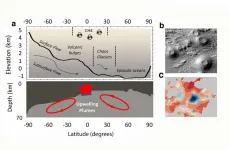(Press-News.org) FLAGSTAFF, Ariz. -- March 16, 2021 -- The findings of a recent analysis conducted by the Translational Genomics Research Institute (TGen), an affiliate of City of Hope, suggest that ecosystems suitable for harboring ticks that carry debilitating Lyme disease could be more widespread than previously thought in California, Oregon and Washington.
Bolstering the research were the efforts of an army of "citizen scientists" who collected and submitted 18,881 ticks over nearly three years through the Free Tick Testing Program created by the Bay Area Lyme Foundation, which funded the research, producing a wealth of data for scientists to analyze.
This new study builds on initial research led by the late Nate Nieto, Ph.D., at Northern Arizona University, and Daniel Salkeld, Ph.D., of Colorado State University.
This immense sample collection represented a multi-fold increase in the number of ticks that could be gathered by professional biologists conducting field surveys in far less time and at a fraction of the cost. This kind of citizen participation -- which in the future could include smart-phone apps and photography -- could become "a powerful tool" for tracking other animal- and insect-borne infectious diseases important for monitoring human and environmental health, according to study results published in the scientific journal PLOS ONE.
This study expands on previous work in California and is the first study to produce high resolution distributions of both actual and potential tick habitat in Oregon and Washington.
"This study is a great example of how citizen scientists can help -- whether tracking climate change, fires, habitat changes or species distribution shifts -- at a much finer scale than ever before," said Tanner Porter, Ph.D., a TGen Research Associate and lead author of the study.
Specifically, Dr. Porter said the findings of this study could help raise awareness among physicians across the West, and throughout the nation, that tick-borne diseases are possible throughout a wider expanse than ever thought before.
Lyme disease is caused by a bacteria, Borrelia burgdorferi (sensu lato), which is carried by ticks, and in this study specifically, the western black-legged tick known as Ixodes pacificus. These ticks also carry pathogens associated with relapsing fever and anaplasmosis, which like Lyme disease can cause fever, headache, chills and muscle aches. Some patients with Lyme disease may experience a rash that may look like a red oval or bull's-eye.
If not treated promptly, Lyme disease can progress to a debilitating stage, becoming difficult and sometimes impossible to cure. This may include inflammation of the heart and brain.
Lyme disease is the most common tickborne illness in the U.S., annually causing an estimated 500,000 infections, according to the CDC. However, even the most commonly-used diagnostic test for Lyme disease misses up to 70% of early stage cases. There is no treatment that works for all patients.
"We hope this study data encourages residents of California, Oregon and Washington to take precautions against ticks in the outdoors, and helps to ensure that local healthcare professionals will consider diagnoses of Lyme when patients present with symptoms," said Linda Giampa, Executive Director of the Bay Area Lyme Foundation.
Citizen scientists were encouraged to mail in ticks collected off individuals' bodies, pets and clothing. They noted the time and place where the ticks were discovered, and described activities involved, the surrounding environment, and in many cases specific GPS coordinates.
Field studies could take decades to produce the same amount of data, said Dr. Porter, adding, "this citizen science technique could allow for real-time distribution monitoring of ticks and other relevant species, an important consideration with emerging pathogens, changing land-use patterns, and climate change."
INFORMATION:
This study builds on TGen's "One Health Collaborative," an initiative that uses a holistic approach to monitor the health of humans, animals and the environment, according to David Engelthaler, Ph.D., head of TGen's infectious disease studies.
The study -- Predicting the current and future distribution of the western black-legged tick, Ixodes pacificus, across the Western US using citizen science collections -- was published Jan. 5 In PLOS ONE.
About TGen, an affiliate of City of Hope
Translational Genomics Research Institute (TGen) is a Phoenix, Arizona-based nonprofit organization dedicated to conducting groundbreaking research with life-changing results. TGen is affiliated with City of Hope, a world-renowned independent research and treatment center for cancer, diabetes and other life-threatening diseases: CityofHope.org. This precision medicine affiliation enables both institutes to complement each other in research and patient care, with City of Hope providing a significant clinical setting to advance scientific discoveries made by TGen. TGen is focused on helping patients with neurological disorders, cancer, diabetes and infectious diseases through cutting-edge translational research (the process of rapidly moving research toward patient benefit). TGen physicians and scientists work to unravel the genetic components of both common and complex rare diseases in adults and children. Working with collaborators in the scientific and medical communities worldwide, TGen makes a substantial contribution to help our patients through efficiency and effectiveness of the translational process. For more information, visit: tgen.org. Follow TGen on Facebook, LinkedIn and Twitter @TGen.
Media Contact:
Steve Yozwiak
TGen Senior Science Writer
602-343-8704
syozwiak@tgen.org
March 16, 2021, Mountain View, CA - In a comment published today in Nature Astronomy, Dr. Nathalie Cabrol, Director of the Carl Sagan Center for Research at the SETI Institute, challenges assumptions about the possibility of modern life on Mars held by many in the scientific community.
As the Perseverance rover embarks on a journey to seek signs of ancient life in the 3.7 billion years old Jezero crater, Cabrol theorizes that not only life could still be present on Mars today, but it could also be much more widespread and accessible than previously believed. Her conclusions are based on years of exploration of early Mars analogs in extreme environments in the Chilean altiplano and the Andes funded ...
Billions of years ago, the Red Planet was far more blue; according to evidence still found on the surface, abundant water flowed across Mars and forming pools, lakes, and deep oceans. The question, then, is where did all that water go?
The answer: nowhere. According to new research from Caltech and JPL, a significant portion of Mars's water--between 30 and 99 percent--is trapped within minerals in the planet's crust. The research challenges the current theory that the Red Planet's water escaped into space.
The Caltech/JPL team found that around four billion years ago, Mars was home to enough water to have covered the whole planet in an ocean about 100 to 1,500 meters deep; a volume roughly ...
URBANA, Ill. - Corn didn't start out as the powerhouse crop it is today. No, for most of the thousands of years it was undergoing domestication and improvement, corn grew humbly within the limits of what the environment and smallholder farmers could provide.
For its fertilizer needs, early corn made friends with nitrogen-fixing soil microbes by leaking an enticing sugary cocktail from its roots. The genetic recipe for this cocktail was handed down from parent to offspring to ensure just the right microbes came out to play.
But then the Green Revolution changed everything. Breeding tools improved dramatically, leading to faster-growing, higher-yielding hybrids than the world had ...
Radio telescopes are the world's most sensitive radio receivers, capable of finding extremely faint wisps of radio emission coming from objects at the farthest reaches of the universe. Recently, a team of astronomers used the National Science Foundation's Karl G. Jansky Very Large Array (VLA) to take advantage of a helping hand from nature to detect a distant galaxy that likely is the faintest radio-emitting object yet found.
The discovery was part of the VLA Frontier Fields Legacy Survey, led by NRAO Astronomer Eric Murphy, which used distant clusters of galaxies as natural lenses ...
Recent research shows that people are more likely to take "microbreaks" at work on days when they're tired - but that's not a bad thing. The researchers found microbreaks seem to help tired employees bounce back from their morning fatigue and engage with their work better over the course of the day.
At issue are microbreaks, which are short, voluntary and impromptu respites in the workday. Microbreaks include discretionary activities such as having a snack, chatting with a colleague, stretching or working on a crossword puzzle.
"A microbreak is, by definition, short," says Sophia Cho, co-author of a paper on the work and an assistant professor ...
RESEARCH TRIANGLE PARK, N.C. -- Joint Army- and Air Force-funded researchers have taken a step toward building a fault-tolerant quantum computer, which could provide enhanced data processing capabilities.
Quantum computing has the potential to deliver new computing capabilities for how the Army plans to fight and win in what it calls multi-domain operations. It may also advance materials discovery, artificial intelligence, biochemical engineering and many other disciplines needed for the future military; however, because qubits, the fundamental building blocks of quantum computers, are intrinsically fragile, a longstanding barrier to quantum computing has been effective implementation of quantum error correction.
Researchers at University of Massachusetts Amherst, ...
Corporate strategies should be as unique as possible, in fact highly specific to each individual company. This enables companies to compete successfully in the long term. However, the capital market and others, including analysts, often react negatively to the idea of unique strategies. The reason is that deviating from typical industry standards makes them more complex to evaluate. This regularly discourages companies from focusing on unique strategies, even though they would be beneficial for the company in the long term. This contradiction is known as the "uniqueness paradox". A research team from the Universities of Göttingen and Groningen has investigated the influence of different types of investors on the extent of the paradox and thus on the choice of unique strategies. The results ...
Higher progesterone level is protective in mild traumatic brain injury
Blood flow in brain is linked to progesterone and stress symptom levels
Most concussion research has been focused on male athletes
CHICAGO --- Could birth control pills help young female athletes recover faster from concussions and reduce their symptoms?
A new Northwestern Medicine pilot study has shown when a female athlete has a concussion injury during the phase of her menstrual cycle when progesterone is highest, she feels less stress. Feeling stressed is one symptom of a concussion. Feeling less stressed is a marker of recovery.
The study also revealed for the first time the physiological reason for the neural protection is increased ...
New research from the University of Florida Warrington College of Business finds that feeling psychologically powerful makes leaders' jobs seem more demanding. And perceptions of heightened job demands both help and hurt powerful leaders.
Trevor Foulk of the University of Maryland Robert H. Smith School of Business and Klodiana Lanaj, Martin L. Schaffel Professor at UF, note that while power-induced job demands are key to helping leaders more effectively pursue their goals and feel that their jobs are meaningful each day at work, these demands can also cause pain and discomfort, felt in the evening at home.
"Power is generally considered a desirable thing, as leaders often seek power, and it's very rare for leaders to turn powerful roles down," Foulk said. "However, this view is qualified ...
WASHINGTON, March 16, 2021 -- Sea-based fish farming systems using net pens are hard on the environment and the fish. A closed cage can improve fish welfare, but fresh seawater must be continuously circulated through the cage. However, ocean waves can cause this circulating water to slosh inside the cage, creating violent motions and endangering the cage and the fish.
A study using a scale-model fish containment system is reported in Physics of Fluids, by AIP Publishing. The study shows why violent sloshing motions arise and how to minimize them.
Gentle currents can be artificially maintained inside cylindrical closed cages developed for salmon farming. The current is produced by injecting seawater through ...


